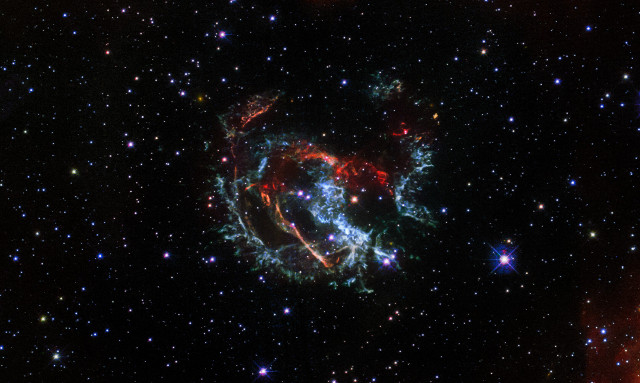
An article under review for publication reports a study on the supernova remnants cataloged as 1E 0102.2-7219 which estimate its place of origin and its age. A team of researchers led by John Banovetz and Danny Milisavljevic of Purdue University in West Lafayette, Indiana, USA, used observations conducted with the Hubble Space Telescope to reconstruct the history of that supernova that occurred in the Small Magellanic Cloud. The conclusion is that the light from the progenitor star’s explosion reached Earth about 1,700 years ago.
Discovered in 1981 by NASA’s Einstein Observatory, a pioneering mission in X-ray astronomy, the supernova remnants 1E 0102.2-7219 have been studied over the decades with various instruments. The origin of the progenitor star was pinpointed in the Small Magellanic Cloud, a dwarf galaxy satellite of the Milky Way, about 200,000 light years from Earth. Its characteristics indicated that its light reached Earth in recent times from an astronomical point of view, but there was no precise estimate of the date. This new research offers some answers.
The led by astronomers John Banovetz and Danny Milisavljevic of Purdue University reconstructed the history of the supernova remnants 1E 0102.2-7219 using observations conducted years apart with the Hubble Space Telescope. An approach of this type was already tried years ago and reported in an article published in “The Astrophysical Journal” in April 2006 but in that case the researchers compared images captured with the Wide Field Planetary Camera 2 (WFC2) with others captured with the Advanced Camera for Surveys (ACS) years later. In this new study, only images captured with the ACS instrument were used, and this makes it easier to trace the trajectory of the clumps of debris ejected by the supernova.
The various debris are moving at different speeds and in different directions from the explosion. In the image, debris clumps moving towards the Earth are visible in blue while the clumps moving away from the Earth are visible in red. Analysis of the images indicates that supernova light reached Earth about 1,700 years ago. It would have been visible from the southern hemisphere, but there’s no historical record about that event.
The researchers also recorded the speed of a suspected neutron star, what remained of the progenitor star’s core, identified by ESO’s Very Large Telescope (VLT) and NASA’s Chandra X-ray Observatory. Its nature is still in doubt and some research suggests that it’s actually a compact remnant of the supernova that was ejected and was lit up. Its speed is over 3 million km/h, at the limit of how fast astronomers believe a neutron star can move, one of the reasons for doubt about its nature.
Research on supernova remnants 1E 0102.2-7219 haven’t finished but this study offers more accurate data in the reconstruction of the events. This will also help understand what really remained after the progenitor star exploded.

